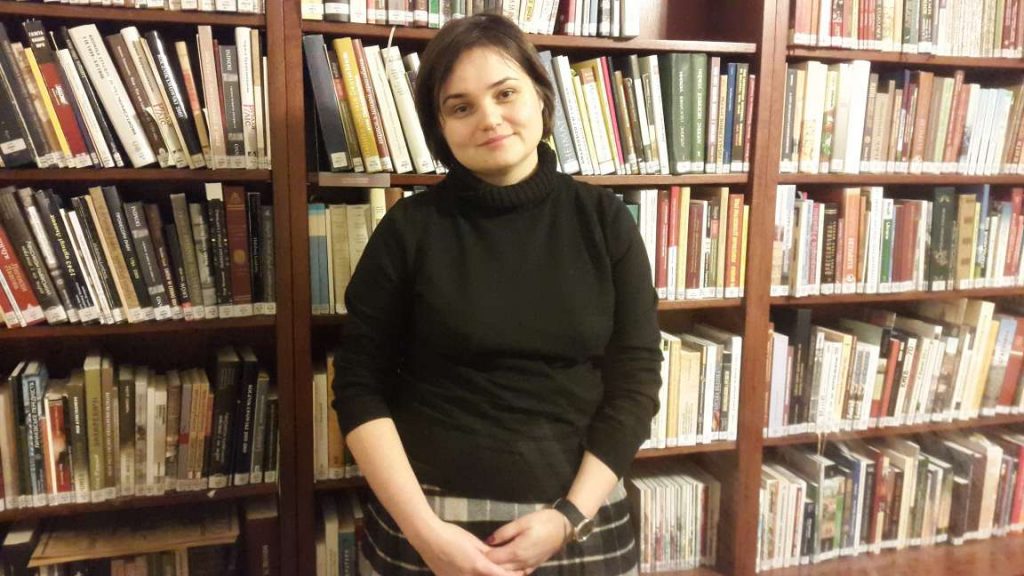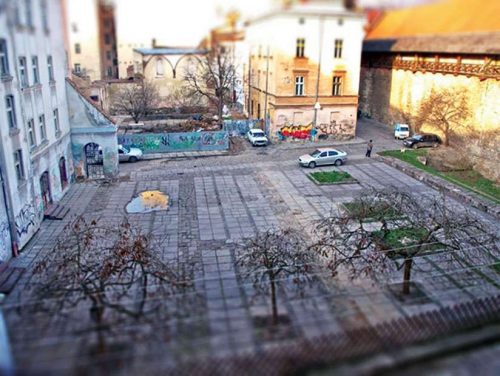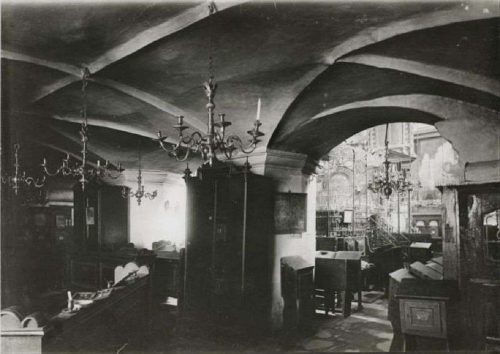Lviv: Not just the history of a place and of buildings, but the history of people

[Editor’s note: Lviv’s Space of Synagogues project was unveiled on Sept. 4, 2016. We are running the transcript of an interview with Sofia Dyak of the Center for Urban History that originally aired last year on Ukraine’s Hromadske Radio so that people visiting the city may learn more about the origins of this important project.]
Today’s guest on “Zustrichi” is Sofia Dyak, Doctor of Historical Sciences and the director of the Center for Urban History of East Central Europe. The focus of our conversation is the Space of Synagogues project, which was mentioned in passing during the previous show.
At the start of the conversation Sofia Dyak talks about the origins of the project and its idea.
Sofia Dyak: The project is called Space of Synagogues. It is now at the implementation stage, work is being done on site; we can call this building works. The project involves three areas that are situated very close to City Hall, that is, the central part of the city. This is a space without a single building, but buildings stood there earlier. As anyone who visits this city can see, Lviv survived the war practically intact, and this circumstance is in sharp contrast if we think of how many people did not survive the war or were unable to return to this city or were unable to remain in it. And what we treasure as a UNESCO world heritage site and that which is used in numerous booklets and promotional videos about the city, this fact both reveals and conceals at one and the same time. And we have encountered this “concealing” that prevents understanding, seeing, thinking…and we have come up against this many times before. The Space of Synagogues looks at a place where there may be nothing for many people, where nothing is interpreted, and for that very reason it [the project] has set itself the goal of making [this place] noticeable, one that can be interpreted.
What are we talking about here? The point is that before the Second World War there were over 130,000 Jews in Lviv. We can also say that prior to 1941, before the Nazi occupation, this number had grown, because there were refugees from the occupied part of Poland. And, according to various estimates, between 800 and 2,000 Jews survived both the Holocaust and the war in Lviv.
Which specific buildings are part of the project? The Golden Rose Synagogue—to be more precise, its ruins and remnants—right now it is noticeable. That is, it is visible right now because a fence has been erected, trees have been removed, but it was inconspicuous in a variety of ways.
Іryna Slavinska: It was inconspicuous as a construction site?
Sofia Dyak: It was inconspicuous in that it could be accessed only through the terrace of a restaurant and through the internal office of the Turei Zahav civic organization. That is, it was necessary in fact to pass through certain levels of knowledge or ignorance. And the idea [for the project] emerged precisely from this knowledge or ignorance. It all began in 2008 at a conference; maybe I’ll return to this, if you’re interested in how it all began. We have a place of ruins that exist but which are described only by a small plaque that states that this is a monument of Renaissance architecture, a building constructed by Paul the Roman [Paolo Dominici Romanus]. In fact, we have a very short history of the building: “Built, destroyed.” But there is absolutely no information about the fact that the Beth Hamidrash stood in front of the Golden Rose building. Everything became overgrown with trees in the last 20 years, and in order to protect the site of the Golden Rose from vandalism, a fence was erected. On the one hand, this fence protected, and, on the other, it barred entry. And before this, it was a parking lot; stands began multiplying there from way back. And this was a place, it was a large municipal synagogue—the third synagogue, to be more precise—because the Beth Hamidrash is a place of learning, so this building has a religious function, but it is not a synagogue.
And the task was very simple: to find a way to display the history of this place, these places. And to show this to various audiences.
Iryna Slavinska: Why do this? Of course, this question relates to the origins of the project but also to its tasks, obviously.
Sofia Dyak: There were many tasks. First of all, honoring the memory of people who were Lvivites. I think this is crucial above all for those who are living in Lviv right now because it is a question of building relations with a place, and going beyond the framework of the narrative in which Lviv always appears as an exclusively Ukrainian city that was under some kind of occupation for many hundreds of years. I think this is part of social maturation, maturity, and respect. If there is respect for the people who created this place, in the very same way this creates respect for the people who live here right now. This is part of social relations—culture and social relations.
The second part is to go beyond the limits of a niche approach, in which we have a separate history of the Poles, a history of the Jews, a history of the Ukrainians, and to show that this is very intertwined, that there are more ways to see everyone together not only ethnically but beyond ethnicity. For example, among the elements of the project is an installation called “Immortalization,” which includes 21 quotations from Jews who lived in Lviv from the eighteenth century to…the last quotation features the words of a woman who survived the Holocaust in Lviv and now lives in Haifa. Her father used to work in a building that is very close by; he was a journalist, the editor of The Wave, a newspaper, the largest Polish-language Jewish newspaper.

This is not just the history of a place and buildings. It is the history of people.
Iryna Slavinska: The question then arises as to what this will be. The history of people, a supra-ethnic, or ethnic look at the various histories of Lviv—these are very important but very far-reaching words. If one imagines someone walking along the street that goes from City Hall and ending up at the Space of Synagogues, where there are three important installations, three structures that are not the only important ones in the Jewish landscape of Lviv, obviously there is a big chance that he or she will pass by without paying attention to it. If we’re talking about the creation of installations, which ones will emerge as a result of the Space of Synagogues project?
Sofia Dyak: This is a commemorative landscape-space project. Hence it works on the basis of contrast, because we are talking about access into a very dense building, where the passerby ends up in the place, and his or her glance falls on the area where there are ruins of the building. These ruins are very noticeable right now because they are not enclosed either by a fence or greenery. This is a complex process of conserving a structure that was the interior but became the exterior, and which, on the one hand, is supposed to be technically and physically safeguarded from damage. This is not just a question of contemplation but also a question of the need to protect the structure from further destruction; at the same time, the perception that something dramatic and tragic took place here.

The material is fashioned out of contrast; this is light-colored concrete known as Venice terrazzo. The foundations of the Beth Hamidrash are marked by such blocks that form the main structure. One sees that this is the foundation, but it is a very clean line that contrasts with the ragged walls of the Golden Rose Synagogue. Inside, there will be greenery. Plus, all around are structures of ochre, some gray color—these are the colors of the surrounding residential buildings, and they create contrast. Against this contrast of clear-cut lines, the question arises: What’s over there?
Iryna Slavinska: And will there be an answer to the question, “What’s over there?”
Sofia Dyak: When you draw near, you can read….There will be a plaque that will recount the history of each of these three structures in quite an encyclopedic fashion—a bit more than simply “built and destroyed.” But there was no opportunity to hear from people, so in walking from the site of Beth Hamidrash from Staroievreiska Street to the Golden Rose [Synagogue], people will be able to see what is there while the works are underway. People walk past the “Immortalization” installation, which features 21 quotations that I mentioned earlier. Each quotation is a dark-gray tile of various sizes. There are 38 tiles, but a total of 21 quotations. Why? This is also a way of showing that we do not pretend to choose all the quotations, because not everyone leaves behind quotations, and there are many voices that we will never hear. But the fact that we will never hear them does not mean that we should not be aware that they once existed. And this is not merely a question of Jewish history; this is a question of history in general. Whom do we hear in society?
Iryna Slavinska: A whole array of assorted agents are taking part in its creation, and in the first part of your answer I would ask you to talk about the institutions that are joining up with you. Cooperation between the non-governmental and state sector, the state and an NGO, does not happen all that often.
Sofia Dyak: A total of three institutions have joined the project. The first institution is the Municipal Council as represented by the Municipal Executive Committee. The Directorate for the Protection of the Historical Environment and the deputy mayor for humanitarian questions participate directly in all the discussions. Representing the Municipal Council in the working group are the head of the Directorate for the Protection of the Historical Environment and the deputy mayor for humanitarian questions. The last two years were without the deputy mayor, but he took part from the beginning: in 2008 it was Vasyl Kostiv. The second institution is a project for municipal development and restoration of the historical quarter of the city of Lviv. This is a German-Ukrainian project that is being carried out by the German Society for International Cooperation. This project was launched in Lviv in 2009. The third institution is the Center for Urban History, which is a civic organization and foundation that combines research—what one might call public history—with educational projects.
These are three very different organizations: an international one with experience and geography spanning the entire world; a municipal government, and a private, non-governmental one. We have functionaries, we have architects, we have historians. That is, we are quite different both professionally and institutionally.
Iryna Slavinska: Who formulated the message?
Sofia Dyak: To be honest, the message was formulated very gradually. That is, it was shaped bit by bit here in this place, where we are sitting right now, in the library of the Center for Urban History. In 2008 there was a conference on the local Jewish heritage in Central and Eastern Europe. Scholars gathered; we also invited experts. We reflected on how to speak, what to say, how to research the legacy of people who are no longer alive, because many are gone; how to talk about this.
This was discussed by the researchers, and after the conference there was an internal discussion to which the deputy mayor was invited. The topic was: if you don’t know history in Lviv, you are not interested, you don’t have any family or friendly relations with Jews or those who study Jewish history, then you can walk around and not have any idea that very many Jews once lived in Lviv. And the question was how this can be visualized, how this can be marked in the urban space.
Ideas came about that this could be shown on the site of the Golden Rose [Synagogue], which is in bad shape and needs attention; it needs dignified treatment and a dignified attitude. Then the next point: there is one site, and two other sites have been selected, but who is to decide? How? That is, there was a situation in which the municipal government was interested in this topic. The project also aimed to include them, and inclusion is when you work on this, when you enter this process the process changes.

The quest for both resolutions and conceptions was translated into the format of the competition, but in order to carry out the competition assignment, it was necessary to prepare it; that too is a certain conception. In order to formulate this conception, a meeting was held with residents and so-called participants of the process surrounding the Space of Synagogues. People gathered: those who live there, people who work there, and those to whom this place is important.
Iryna Slavinska: By the way, was there a reaction? What I mean is, did the residents of this area come to the meeting?
Sofia Dyak: Yes, they came. An excursion was also organized for them, which was led by a person who lived in Lviv in 1939 and had seen these buildings standing. Then there was the usual tea party; we sat at a place next door and posed questions that are often asked before any kind of competition: what do you like? what do you dislike? what can be done? what must not be done? what information would you like to offer? And a map on which we tried to include as much as possible took shape. The people who came together are very different, and different people expect different things; this is understandable. The decision about whether to rebuild the synagogue or not was beyond the realm of possibility and responsibility of the local administration; this is something else completely. But it was clear that there were people for whom this was important. Accordingly, within the conditions of the competition it was anticipated that those decisions which were being proposed must include the possibility of rebuilding the Golden Rose [Synagogue] in future.
This is known as reversibility. The project is supposed to show the history of a place, become part of today and the civic space, to try and find the language of a memorial on the edge of these two [concepts], as well as to give the future a chance, if new people come and find new resolutions, that this can be changed. This may happen in 10 or 15 years, and it is important not to block possibilities in future.
Then came a lengthy process of discussions and additional work from conception to project. This story has been ongoing for nearly five years, over the course of which things came together about the educational component and what conservation is supposed to look like. This is a job of working out the details because, for example, the space requirements of a site that is partially preserved are one thing; where the foundation alone exists is another. For example, when we were selecting the 21 quotations, researchers were engaged in this, because behind one quotation there may be someone who wrote a book, but this has to be found and proposed. There is power and there is the authority of experts; but there is also the question of how this power can be shared. And whereas historians and literary specialists proposed nearly 70 or 80 texts, tiny texts, the selection was up to the representatives of the Jewish community. A representative of the organizers from the local government also took part…. And here too is a question of authority, which must be shared. This is joint participation; it is not something that is imposed; it is that which is reached through dialogue.
We, for example, do not stop the narrative in 1944. There are the Jews who arrived in Lviv after the war; they have a history that also has a place here and which must resound. There are the voices of people who are now living in other countries, in Israel or America, and this second half of the twentieth century is included too. I think this is important. Apart from the entire, rich history of Lviv up to the Second World War and what happened during the Second World War, we have another fifty years: these are people who are still living; these are people, and stories that are closer [to us in time], and it is definitely worthwhile including them.
This program is created with the support of the Canadian philanthropic fund Ukrainian Jewish Encounter.
Originally appeared in Ukrainian (Hromadske Radio podcast) here.



















